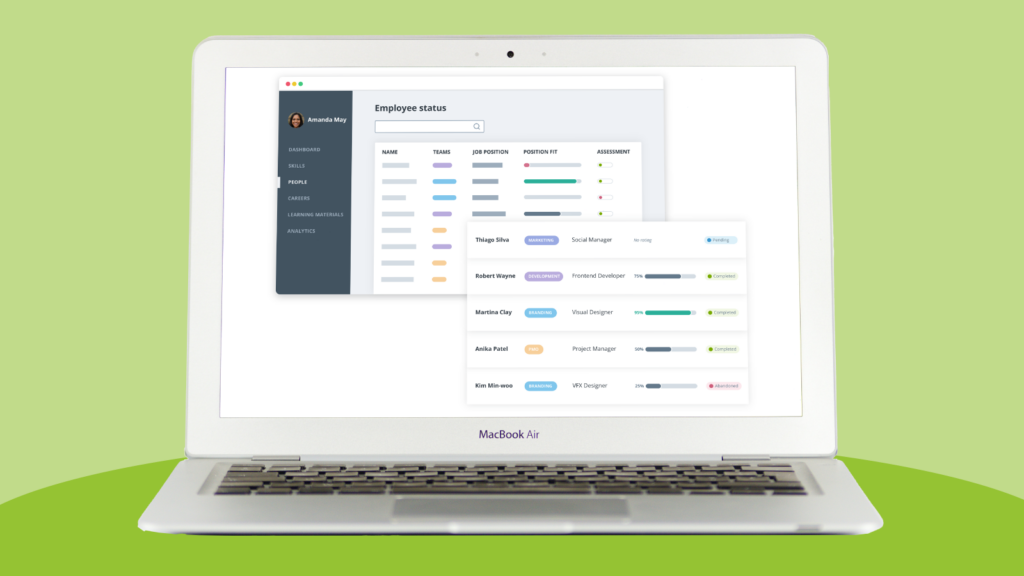Upskilling platforms: The future of learning

- Introduction
- Why upskilling?
- Benefits of using upskilling platforms
- Types of upskilling platforms
- Choosing the right platform
- How to get the most out of an upskilling platform
- Potential challenges
- The return on investment (ROI) of upskilling
- Upskilling vs. reskilling: What’s the difference?
- The role of data in upskilling platforms
- Integrating upskilling into daily workflows
- Feedback and iteration: Refining the upskilling process
- Global impact: Upskilling for a borderless world
- Final word
- FAQs
Introduction
It’s a common concern for companies to ponder whether their team’s skills remain pertinent and competitive.
In this high-velocity digital age, ensuring that your workforce is constantly upskilled isn’t just a luxury; it’s a business imperative.
The crucial dilemma for many businesses is identifying the most effective way to empower their teams with the latest knowledge, and expertise.
This is where our upskilling platforms come into play, offering bespoke solutions tailored to your organization’s needs, ensuring you stay at the forefront of industry advancements.
Why upskilling?
Amidst the whirlwind of today’s business dynamics, have you taken a moment to reflect on the astonishing rate at which the professional landscape is changing?
With technology and automation reigning supreme, we witness some job roles wane and become obsolete, while others emerge and flourish seemingly out of nowhere. In this ever-shifting terrain, the question beckons: How does one stay relevant and agile?
Navigating this evolving marketplace requires a keen sense of adaptability and a commitment to continuous learning. For businesses, understanding these changes and preparing their teams for the challenges and opportunities they bring is not just strategic—it’s essential.
Benefits of using upskilling platforms
Imagine your organization navigating a static market position, while competitors forge ahead, seizing innovations and new ventures. Then, picture a transformative shift within your company, where teams are re-energized, unlocking novel solutions, driving growth, and capturing previously untouched opportunities.
This organizational renaissance is a testament to the power of upskilling. Platforms curated for this precise purpose offer more than just a run-of-the-mill online learning experience; they serve as engines propelling businesses towards sustained success and resilience.
Embracing the ethos of lifelong learning, these platforms ensure that your workforce is not only aligned with today’s industry standards but is also primed to develop, anticipate and respond to the shifting sands of tomorrow’s market demands.
They act as essential bridges, connecting the current competencies within your company to the evolving skill sets demanded by the modern business landscape.
In a rapidly changing corporate world, isn’t it reassuring to know that with the right tools and strategies, your organization can lead the charge, setting benchmarks and defining industry excellence?
Types of upskilling platforms
Consider the upskilling platform as a vast reservoir of industry-specific insights and expertise, tailor-made for organizational growth. In this expansive realm, avenues like online courses, interactive workshops, webinars, take classes and structured mentorship programs cater not just to individual employees, but to entire departments and verticals, ensuring synchronized growth and development. For businesses, these platforms are not just tools, but strategic assets.

They empower workforces with the latest industry knowledge, promote innovation, and ensure that companies remain agile in a rapidly evolving market. With a plethora of digital marketing options available, the question arises: How can an organization best harness this resource?
In the B2B landscape, the need for an upskilling tool goes beyond personal development and professional certification. It’s about ensuring that your company stays competitive, reduces the skills gap, and fosters a culture of continuous learning and innovation. Such platforms not only equip your team with the requisite skills but also position your business as a forward-thinking entity, ready to adapt, evolve, and lead in its respective sector.
Choosing the right platform
Selecting an upskilling platform for your organization can be likened to choosing a new machinery or software system.
Just as you wouldn’t invest in new equipment without evaluating its specifications, compatibility, and the manufacturer’s credibility, the same scrutiny applies when integrating an upskilling solution.
Before committing, it’s imperative to assess the specific needs of your organization, verify the platform’s track record in the corporate sector, and ensure the content aligns with the current and future demands of your industry.
In the B2B landscape, making an informed decision based on these parameters can be the difference between an asset that drives growth and a misaligned investment.
How to get the most out of an upskilling platform
Has your organization ever invested in software or tools only to realize they’re underutilized? Merely procuring a solution doesn’t translate to instant results. It’s essential to set clear organizational goals, actively engage with the platform’s features, and foster collaboration and discussions among teams.
After all, in the business realm, value is derived not just from individual knowledge but from collective understanding and application.
Potential challenges
Embarking on an upskilling initiative for your organization can be a thrilling prospect, signaling a commitment to innovation and growth. However, like any significant business transformation, it comes with its set of challenges.
The vast array of platforms, courses, and methodologies available can often leave decision-makers in a quandary. Finding the right fit that aligns with the company’s goals and industry standards is crucial, yet can feel like navigating a labyrinth.
Beyond the initial selection, ensuring consistent engagement across the organization, maintaining motivation among teams, and verifying that the skills acquired remain relevant to the ever-evolving market demands are tasks that require strategic foresight and diligence.
Nevertheless, with the right approach and mindset, these hurdles can be transformed into stepping stones, paving the way for a future-ready enterprise. Are you poised to turn challenges into opportunities?
The return on investment (ROI) of upskilling
Every strategic decision, especially those involving financial outlays, is subjected to scrutiny concerning its potential Return on Investment (ROI).

Upskilling, while predominantly viewed as a means to bolster competencies, should also be approached with the same ROI mindset. Let’s delve deep into the tangible and intangible benefits of investing in continuous learning for organizations.
Tangible returns
Enhanced productivity
Upskilled employees can often execute tasks more efficiently, leading to faster turnaround times and higher output. This uptick in productivity can directly correlate with an organization’s bottom line, producing visible gains in revenue.
Reduced recruitment costs
Rather than sourcing external talent for specialized roles, which incurs recruitment and onboarding costs, upskilling can enable businesses to promote from within. This not only reduces direct hiring expenses but often leads to a more seamless transition given the individual’s existing familiarity with company culture and operations.
Lower attrition rates
Employees value professional development. Organizations that prioritize upskilling often witness reduced turnover rates, which in turn saves costs related to hiring and training replacements.
Intangible returns
Enhanced company reputation
In the B2B ecosystem, a company’s reputation is paramount. Organizations known for their commitment to employee development are often perceived as industry leaders and preferred partners. This intangible goodwill can open doors to lucrative partnerships and collaborations.
Fostering a culture of innovation
Continuous learning often instills a sense of curiosity and encourages innovative thinking. This can lead to breakthrough ideas, product enhancements, and unique service offerings, differentiating the organization in a competitive marketplace.
Improved employee morale and satisfaction
Investing in employee growth demonstrates that the company values its workforce. This boosts morale and fosters a sense of loyalty, leading to a more engaged, motivated, and harmonious workplace.
Agility in market response
Upskilled teams are better equipped to respond to industry shifts and market changes. This adaptability ensures that businesses remain relevant, can pivot when required, and capitalize on new opportunities.
Upskilling vs. reskilling: What’s the difference?
Businesses are frequently confronted with the need to adapt and evolve, ensuring their workforce remains competent and aligned with industry shifts.

Two buzzwords often emerge in this context: “upskilling” and “reskilling.” While they might seem interchangeable at first glance, understanding their nuanced differences is crucial for decision-makers aiming to make informed strategic choices for their organization’s future. Let’s dissect these terms and explore their implications in the B2B domain.
Upskilling: Enhancing current skill sets
Upskilling refers to the process of providing employees with advanced skills or training in their current roles, allowing them to perform their existing tasks more efficiently or take on more complex responsibilities within the same domain.
When is it appropriate?
- Market evolution: When the industry witnesses incremental changes that demand employees to refine or augment their current skill sets.
- Role enhancement: When you want employees to take on more advanced tasks within their current roles, thereby increasing their contribution and value to the team.
- Technological advancements: In the face of new software or tools that optimize current processes, upskilling ensures the workforce is equipped to harness these advancements.
Reskilling: Pivoting to new roles or domains
Reskilling is the process of training employees to take on entirely different roles, often due to their current roles becoming obsolete or less relevant in the changing business landscape.
When is it appropriate?
- Industry disruption: When technological advancements or market shifts render certain roles or departments redundant.
- Diversification & expansion: As businesses branch out into new markets or services, reskilling can enable leveraging the existing workforce for these new ventures.
- Risk mitigation: In industries susceptible to rapid changes, reskilling serves as a proactive strategy, preparing teams for potential shifts, thus ensuring business continuity.
Implications for B2B entities:
For B2B companies, understanding the difference between upskilling and reskilling is more than just a linguistic exercise. The choice between these strategies can shape their competitive edge, financial expenditures, and talent retention.
- Cost efficiency: Reskilling can often be more cost-effective than hiring new talent, preserving institutional knowledge while adapting to industry changes.
- Client expectations: B2B clients seek partners that can evolve with their needs. Demonstrating a commitment to upskilling and reskilling can position a company as adaptive and future-ready.
- Employee retention: Offering opportunities for both upskilling and reskilling can boost employee morale and loyalty, reducing turnover and ensuring sustained organizational growth.
The role of data in upskilling platforms
In the realm of learning and development, especially within a B2B context, analytics and other data science-driven insights have transformed the way organizations approach upskilling web development and training. Here’s a deep dive into how these elements shape and enhance the learning journey.
Real-time progress tracking
With the integration of analytics, trainers and administrators can monitor learners’ progress in real-time. This allows for immediate feedback, ensuring that learners remain on track and any deviations or struggles are promptly addressed.
Personalized learning paths
Through data-driven insights, it’s possible to understand the strengths, weaknesses, preferences, and pace of each learner. This allows for the creation of tailored learning paths, ensuring content is relevant, challenging, and aligned with students’ individual goals.
Predictive analysis
Using historical data and current progress metrics, predictive analytics can forecast potential challenges or areas where a learner might struggle. This foresight enables proactive intervention, ensuring a smoother and more effective learning experience.
Benchmarking performance
Analytics allows organizations to benchmark individual or team performance against industry standards or internal KPIs. This provides a clear picture of where they stand and what areas need further attention.
Enhancing engagement
Data can provide insights into which modules or machine learning and methods are the most engaging. If certain content sees higher interaction, repetition, or positive feedback, it signals its effectiveness and can be used as a model for future modules.
ROI on learning initiatives
For businesses, every investment demands a return. Analytics provides a clear metric on the ROI of learning initiatives, showcasing improvements in performance, productivity, or other key business metrics post-training.
Continuous improvement
By continually collecting and analyzing data, organizations can identify areas of their training programs that can be enhanced, ensuring that content remains up-to-date, relevant, and effective.
Boosting collaborative learning
Data-driven insights can highlight areas where collaborative learning or group projects might be beneficial. Identifying topics or modules where learners often struggle can lead to the integration of group discussions or workshops to facilitate peer-to-peer learning.
Identifying learning trends
Over time, analytics can reveal trends in organizational learning – be it a growing interest in certain topics, the effectiveness of specific training methodologies, or shifts in learning pace. These trends can inform future corporate training strategies.
Integrating upskilling into daily workflows
Embedding continuous learning into daily workflows and operations is crucial for sustained success. To achieve this, organizations can employ strategies like microlearning, which breaks information into manageable pieces, and integrate ‘knowledge bytes’ into regular meetings for consistent exposure to new insights.
Leveraging collaborative tools like Slack or Microsoft Teams can facilitate the sharing of relevant industry materials, while encouraging peer-to-peer teaching ensures knowledge dissemination. Integrations between daily tools and Learning Management Systems make learning materials readily accessible, and setting aside dedicated short learning breaks can further reinforce consistent skill enhancement.

Immediate application of new skills, gamification of the learning process, and fostering spaces for free and open discussions can further enrich the learning experience. Setting clear objectives for each learning endeavor, collecting regular feedback, and having leadership champion the importance of continuous education by example further emphasizes its significance.
By weaving these critical skills and strategies together, businesses can ensure learning becomes an integral, impactful part of their daily operations.
Feedback and iteration: Refining the upskilling process
Feedback is the linchpin of effective learning, acting as the compass that guides the iterative process of personal and professional growth. Within the learning ecosystem, feedback operates on multiple dimensions, each critically influencing the trajectory of one’s development.
From a learning platform’ perspective, feedback provides a diagnostic snapshot of the learner’s current capabilities and areas that require enhancement. Automated feedback, generated through quizzes, simulations, or interactive modules, offers instantaneous insights.
This real-time feedback allows for immediate course correction, ensuring that misconceptions or errors don’t become deeply entrenched. Over time, aggregate feedback from the platform can map out a learner’s progress, highlighting strengths developed and areas that still require attention.
Peer feedback introduces a human element, bringing a diverse set and range of perspectives and experiences to the table. Fellow learners or colleagues can often identify nuances or provide context that a platform might miss.
This form of feedback is invaluable, as it promotes deeper understanding and collaborative problem-solving. It fosters a community-driven learning environment where individuals benefit from shared insights, diverse experiences, and mutual support.
Moreover, feedback in both these forms establishes a cyclical process of learn-assess-improve. It not only identifies gaps but also motivates learners by celebrating their progress.
In an era where learning dynamics are rapidly shifting, regular feedback is essential to ensure that content remains relevant, methods remain effective, and learners remain engaged.
In sum, for continuous improvement in the learning journey, feedback is indispensable. It bridges the gap between current capabilities and desired outcomes, ensuring that learning remains a focused, adaptive, and ever-evolving process.
Global impact: Upskilling for a borderless world
Upskilling, while often framed within the context of individual or organizational growth, carries monumental implications on a global scale. Its potential to address skill gaps can catalyze economic upliftment in developing nations by harnessing their youthful demographics and converting latent potential into tangible productivity.
Beyond individual nations, upskilling promotes labor mobility, enabling workers to access opportunities across borders with universally recognized skills and credentials. This universal enhancement of skills paves the way for enriched international collaboration, allowing diverse entities—be they businesses, research and educational institutions,, or governments—to unite in addressing shared challenges, from environmental issues to technological advancements. The resultant global innovation arises from the confluence of diverse, upskilled minds, fostering solutions that resonate across borders.
Furthermore, as regions traditionally lagging in development are empowered through upskilling, economic disparities on a global scale begin to diminish, leading to a more balanced economic landscape.
In essence, upskilling transcends its immediate context, emerging as a beacon for global development, collaboration, and unity in our increasingly interconnected world.
Final word
In this whirlwind of technological advancements and changing job dynamics, upskilling platforms are our compass, guiding us towards relevancy and growth. As the adage goes, “The more you learn, the more you earn.”
Discover how DevSkiller upskilling tool can help you.
Schedule a demo with one of our product experts or watch this quick 5-min demo video to find out more.
FAQs
- What are upskilling platforms?
Upskilling platforms are online educational platforms designed to help individuals enhance their skills and create them for personal and professional growth.
- Are these platforms suitable for everyone?
Absolutely! Whether you’re a novice or an expert in your field, there’s always something new to learn.
Share post